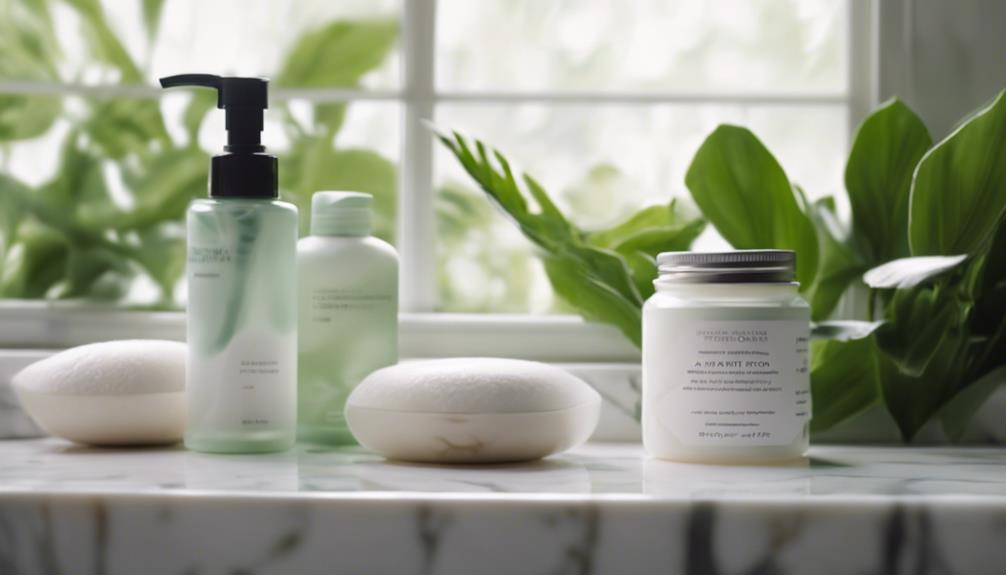To address breakouts on oily, acne-prone skin, it is recommended to start by using a mild, pH-balanced cleanser to eliminate excess oil twice daily. After cleansing, follow up with a water-based toner and incorporate serums that contain niacinamide and salicylic acid to regulate sebum production and unclog pores. Finish off with a lightweight, oil-free moisturizer to moisturize the skin without adding extra shine. Additionally, exfoliating 2-3 times a week is essential to remove dead skin cells, and remember to always apply broad-spectrum sunscreen during the day. It is important not to overlook lifestyle modifications such as a healthy diet and stress management, as they also play a crucial role in achieving clearer skin. There is much more to discover on this topic.
Key Takeaways
- Start with a gentle, pH-balanced cleanser to remove excess oil without causing irritation.
- Use a water-based toner to prepare the skin for treatment after cleansing.
- Apply serums containing niacinamide and salicylic acid to control sebum and target breakouts.
- Follow up with a lightweight, oil-free moisturizer to maintain hydration without clogging pores.
Understanding Oily Skin
Oily skin results from your sebaceous glands producing excess sebum, leading to a shiny complexion and a greater risk of acne. If you notice a slick appearance, especially in your T-zone, you likely have oily skin. This condition can make you more prone to breakouts, which can be frustrating.
To combat this, it's important to establish a proper skincare routine that focuses on cleansing and balancing your skin. Start by using a gentle cleanser designed for oily skin to remove excess oil without stripping your skin of vital hydration.
Incorporating a chemical exfoliant into your routine can help unclog pores and prevent acne. Look for non-comedogenic products, which won't clog your pores and can help manage the oiliness without causing additional breakouts.
While it may seem counterintuitive, maintaining hydration is important. Oily skin can still benefit from lightweight moisturizers that provide hydration without adding excess oil.
Essential Ingredients for Care
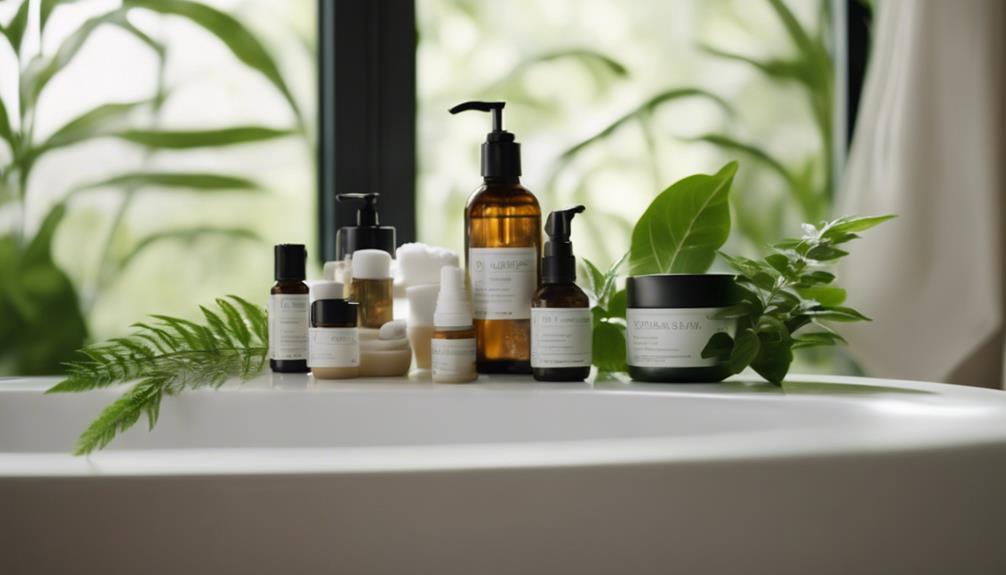
When it comes to caring for oily skin, the right ingredients can make all the difference.
You'll want to focus on key active ingredients like hyaluronic acid, niacinamide, and salicylic acid, which hydrate, regulate oil, and combat breakouts.
Understanding how these components work together will help you achieve a balanced, healthy complexion.
Key Active Ingredients
To effectively care for oily skin, incorporating key active ingredients like hyaluronic acid and niacinamide can make a noticeable difference in your skincare routine.
Hyaluronic acid acts as a powerful humectant, holding up to 1,000 times its weight in water, ensuring your skin stays hydrated without clogging pores.
Niacinamide is vital for regulating sebum production, which helps reduce pore size and improves your skin barrier function, making it ideal for acne-prone skin.
Adding salicylic acid to your oily skin routine is significant, as it penetrates deep into clogged pores to exfoliate and dissolve excess oil, preventing breakouts.
Glycolic acid, a beneficial alpha hydroxy acid, promotes cell turnover and brightens your complexion while reducing the appearance of acne scars.
Lastly, don't overlook retinoids; they enhance skin cell turnover and tackle signs of aging while minimizing the risk of clogged pores.
By incorporating these active ingredients, you can effectively manage oily skin, improve skin texture, and keep acne at bay.
Make these vital ingredients a staple in your routine for clearer, healthier skin.
Benefits of Hydration
Hydration plays an essential role in caring for acne-prone skin, helping to maintain a balanced moisture barrier that reduces excess oil production and breakouts. When your skin is well-hydrated, it's less likely to overproduce sebum, which can lead to clogged pores and inflammation. Key ingredients like hyaluronic acid and niacinamide are crucial in this process.
| Ingredient | Benefits | How It Works |
|---|---|---|
| Hyaluronic Acid | Deep hydration | Holds up to 1,000 times its weight in water, ensuring moisture without added oil. |
| Niacinamide | Controls sebum production | Improves hydration and enhances skin barrier function, reducing breakouts. |
| Ceramides/Glycerin | Improves skin texture | Prevents moisture loss, leading to smoother, clearer skin. |
Regularly incorporating these hydrating ingredients can greatly improve your skin's texture, reduce the frequency of breakouts, and promote a healthier appearance. By focusing on hydration, you're not just treating oily skin; you're nurturing it, ultimately leading to a more balanced and radiant complexion.
Step-by-Step Skincare Routine
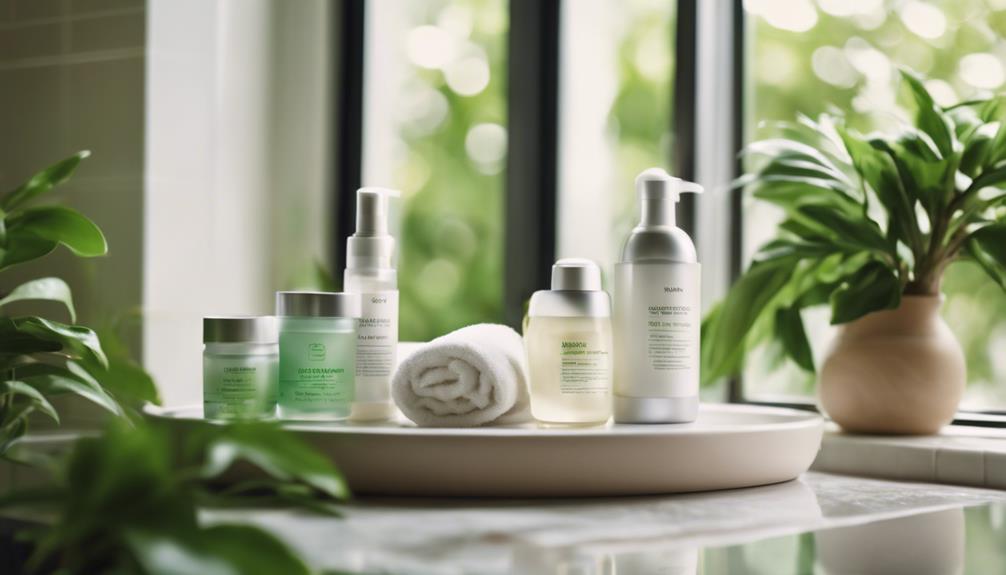
Start your day with a gentle, pH-balanced cleanser that effectively removes excess oil without stripping your skin.
After cleansing, apply a water-based toner to prepare your skin for further treatment.
Next, reach for serums containing niacinamide and vitamin C. These powerful ingredients help control sebum production and brighten your complexion, reducing the appearance of dark spots and uneven skin tone.
Follow up with a lightweight, non-comedogenic moisturizer that maintains hydration without clogging your pores. Look for formulas with hyaluronic acid for an extra boost of moisture.
In the evening, practice double cleansing to thoroughly remove makeup and impurities.
After cleansing, incorporate chemical exfoliation 2-3 times a week using AHAs or BHAs. This promotes cell turnover and helps prevent clogged pores. Allow a 30-minute wait time after exfoliating before applying treatment serums.
Finish your nighttime routine with retinoids or benzoyl peroxide to target acne and refine skin texture.
Consistency is key, so stick to this regimen to manage breakouts and achieve a clearer complexion.
Products to Use and Avoid
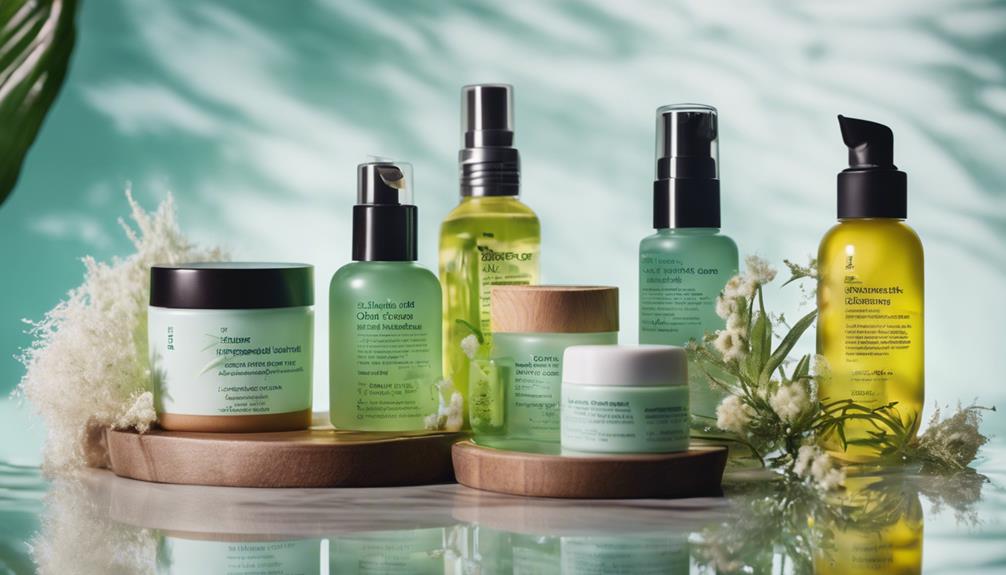
Selecting the right products can make all the difference in managing oily skin effectively. For hydration, choose non-comedogenic, oil-free moisturizers like the Ultra-Light Moisturizing Lotion. These options hydrate your skin without clogging pores, which is essential for preventing breakouts.
Incorporate targeted treatments containing salicylic acid or benzoyl peroxide to effectively combat acne. These ingredients work wonders in reducing blemishes and preventing future flare-ups.
When shopping for products, avoid heavy oils and comedogenic ingredients such as cocoa butter and lanolin, as they can block pores and worsen your skin's condition. It's also best to steer clear of alcohol-based toners; they can lead to over-drying, prompting your skin to produce even more oil.
Look for fragrance-free products to minimize irritation, especially if your skin is sensitive. Fragrances can exacerbate existing issues, making it important to choose gentler alternatives.
Tips for Managing Breakouts

Managing breakouts effectively requires a consistent approach that combines proper cleansing, targeted treatments, and regular exfoliation.
Start by establishing a cleansing routine; wash your face twice daily with a gentle, non-comedogenic cleanser. This helps remove excess oil and dirt without over-stripping your skin.
Incorporate targeted treatments with active ingredients like salicylic acid to unclog pores and benzoyl peroxide to reduce acne-causing bacteria. Remember, even oily skin needs moisture, so use an oil-free moisturizer to hydrate skin without adding extra oil. Skipping moisturizer can actually lead to increased oil production!
Regular exfoliation is key, too. Aim for 2-3 times a week using chemical exfoliants like AHAs or BHAs to remove dead skin cells and improve skin texture.
Last but not least, protect your skin with a broad-spectrum sunscreen of SPF 30 or higher, as sun exposure can eventually worsen breakouts.
- Maintain a consistent cleansing routine.
- Choose products with active ingredients for targeted action.
Lifestyle Changes for Better Skin
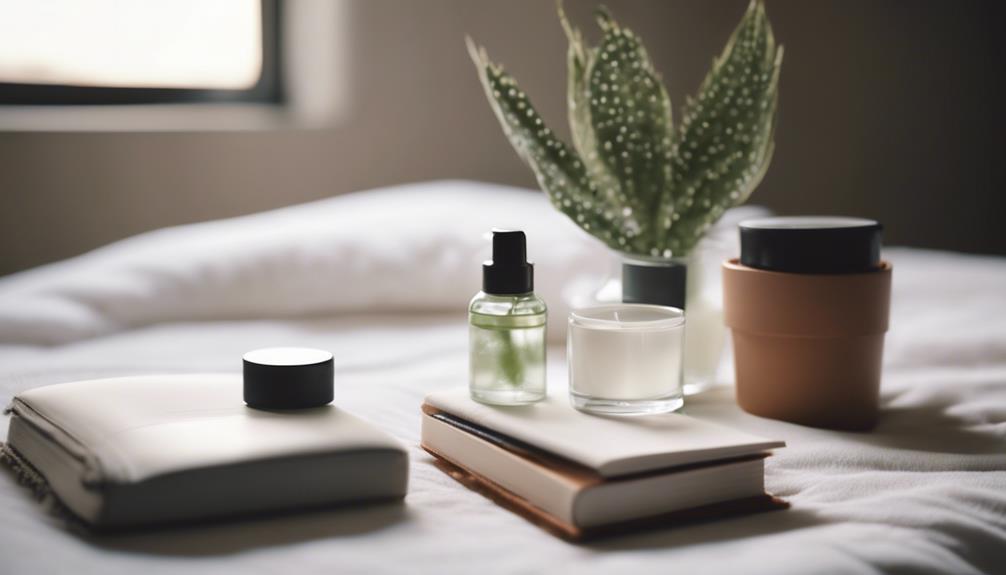
Making simple lifestyle changes can greatly improve your skin's health and help reduce oiliness and breakouts. Start by adopting a low-glycemic diet, focusing on whole foods while steering clear of high-sugar options. This can notably reduce acne breakouts and improve skin health.
Staying hydrated is also essential; aim for at least 8 glasses of water daily to maintain skin elasticity and flush out toxins.
Incorporating anti-inflammatory foods like fruits, vegetables, and omega-3 fatty acids into your meals can enhance your skin quality. Regular physical activity plays a key role too. It boosts blood circulation, reduces stress, and helps regulate hormones that trigger acne.
You might also want to think about avoiding dairy products. Research suggests a potential link between dairy consumption and increased acne risk for some individuals.
Are Skincare Routines for Fungal Acne and Oily Acne-Prone Skin Similar in Managing Breakouts?
When it comes to managing breakouts for fungal acne and oily acne-prone skin, the skincare routines can have some similarities. Both require products that are non-comedogenic and gentle on the skin. However, a fungal acne skincare routine may involve anti-fungal treatments to specifically target the yeast that causes the breakouts.
Conclusion
To summarize, managing oily, acne-prone skin is all about understanding your unique needs and sticking to a tailored routine.
Did you know that nearly 85% of people experience acne at some point in their lives? By incorporating essential ingredients and making mindful lifestyle changes, you can greatly reduce breakouts.
Remember, consistency is key, so commit to your skincare regimen and watch your skin transform.
You've got this—you're one step closer to clearer, healthier skin!
